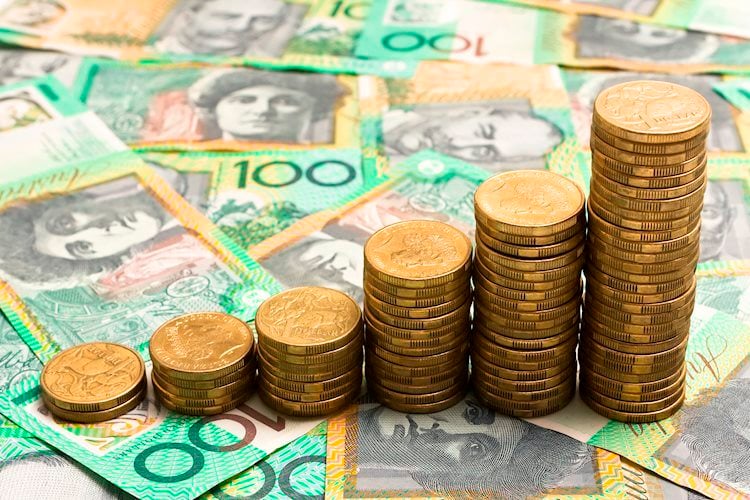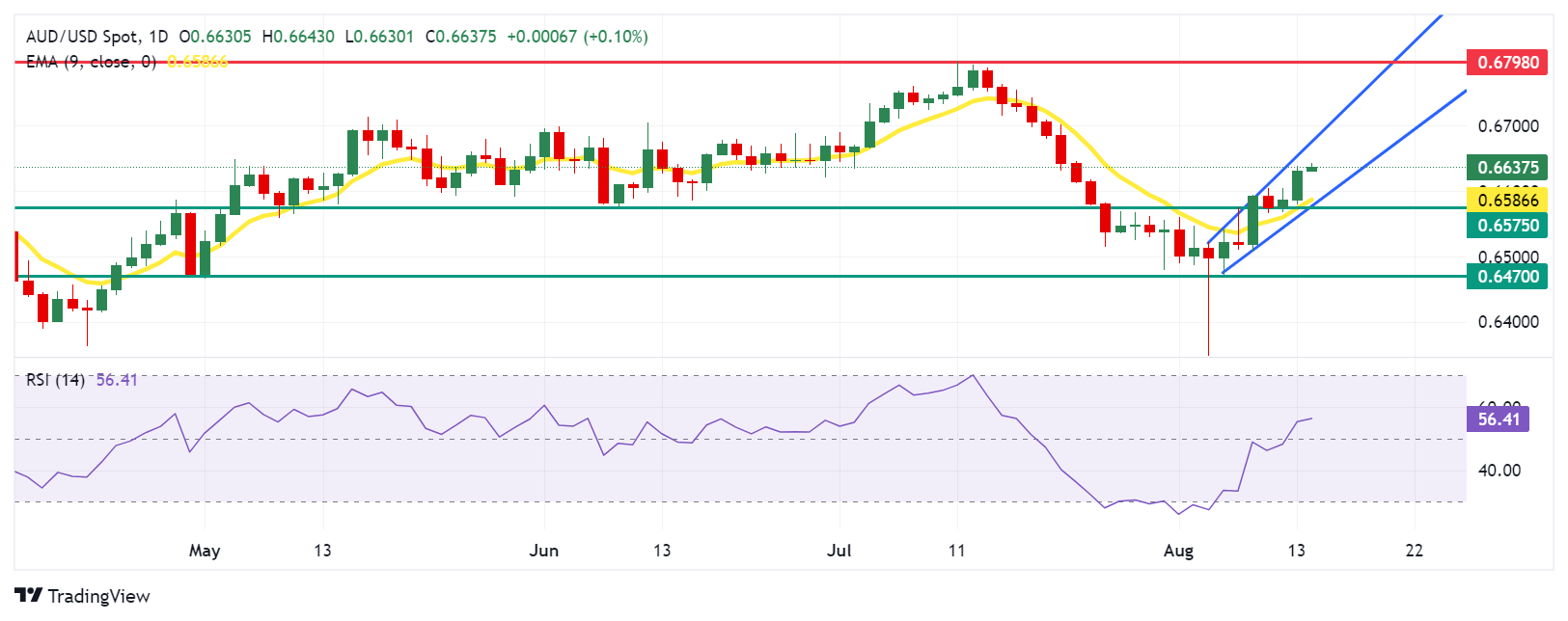Products You May Like
- The Australian Dollar appreciates as recent labor data reduces the likelihood of an RBA rate cut in the near term.
- The Aussie Dollar may face challenges due to safe-haven flows amid rising geopolitical tensions in the Middle East.
- The US Dollar experienced losses following downbeat Producer Price Index data on Tuesday.
The Australian Dollar (AUD) extends its gains for the third successive session against the US Dollar on Wednesday. The AUD/USD pair may advance further as recent data shows that Australian wage growth remained elevated in the second quarter, prompting the Reserve Bank of Australia (RBA) to adopt a hawkish stance regarding its policy outlook.
The RBA maintained the cash rate at last week’s meeting to ensure inflation returns to its 2-3% target. RBA Governor Michele Bullock also dismissed the possibility of rate cuts for the next six months, emphasizing that the Australian central bank remains cautious about inflation risks and is prepared to raise rates again if necessary. Traders are now awaiting the release of Consumer Inflation Expectations and Employment data from Australia on Thursday.
The AUD/USD pair received support as the US Dollar lost ground following lower-than-expected Producer Price Index (PPI) data from the United States (US) released on Tuesday. Investors will likely observe the US CPI inflation report on Wednesday, which could offer some hints about the Federal Reserve’s (Fed) interest rate cut path.
Daily Digest Market Movers: Australian Dollar appreciates as traders expect the RBA to remain hawkish
- On Tuesday, Atlanta Fed President Raphael Bostic stated that recent economic data has increased his confidence that the Fed can achieve its 2% inflation target. However, Bostic indicated that additional evidence is required before he would support a reduction in interest rates, according to Reuters.
- The US Core Producer Price Index (PPI) rose by 2.4% year-on-year in July, against the previous reading of 3.0%. The index fell short of an estimate of 2.7%. The Core PPI remained unchanged.
- The US PPI rose 2.2% YoY in July from 2.7% in June, falling short of the market expectation of 2.3%. Meanwhile, the PPI increased 0.1% MoM after rising by a 0.2% in June.
- Australia’s Westpac Consumer Confidence rose by 2.8% in August, swinging from a 1.1% fall in July. Meanwhile, the Wage Price Index remained steady with a 0.8% rise in the second quarter, slightly below the market expectation of a 0.9% increase.
- On Monday, Reserve Bank of Australia (RBA) Deputy Governor Andrew Hauser attributed persistent inflation to weaker supply and a tight labor market. Hauser also noted that economic forecasts are surrounded by significant uncertainty.
- The upside of the risk-sensitive AUD could be restrained due to safe-haven flows amid increased geopolitical tensions in the Middle East. On Sunday, Defense Minister Yoav Gallant informed US Defense Secretary Lloyd Austin that Iran’s military activities indicate preparations for a significant strike on Israel, as reported by Axios writer Barak Ravid.
- On Sunday, Federal Reserve Governor Michelle Bowman stated that she continues to see upside risks for inflation and ongoing strength in the labor market. This suggests that the Fed may not be prepared to cut rates at their next meeting in September, according to Bloomberg.
- Last week, Westpac updated its RBA forecast, now predicting the first rate cut will occur in February 2025, a shift from the previously anticipated November 2024. They also revised their terminal rate forecast to 3.35%, up from the previous 3.10%. The RBA is now viewed as more cautious, needing stronger evidence before considering rate cuts.
Technical Analysis: Australian Dollar rises to near 0.6650
The Australian Dollar trades around 0.6640 on Wednesday. The daily chart analysis indicates that the AUD/USD pair moves upward within an ascending channel, signaling a strengthening bullish bias. Additionally, the 14-day Relative Strength Index (RSI) has surpassed the 50 level, confirming the bullish momentum.
On the upside, the AUD/USD pair might test the upper boundary of the ascending channel at the 0.6675 level. A breakout above this level could push the pair toward its six-month high of 0.6798, reached on July 11.
In terms of support, the AUD/USD pair might test the nine-day Exponential Moving Average (EMA) at 0.6587, followed by the lower boundary of the ascending channel and the throwback level at 0.6575. A decline below the latter could strengthen a bearish outlook, potentially pushing the pair toward the throwback level at 0.6470.
AUD/USD: Daily Chart
Australian Dollar PRICE Today
The table below shows the percentage change of Australian Dollar (AUD) against listed major currencies today. Australian Dollar was the strongest against the New Zealand Dollar.
| USD | EUR | GBP | JPY | CAD | AUD | NZD | CHF | |
|---|---|---|---|---|---|---|---|---|
| USD | 0.00% | -0.02% | 0.01% | 0.02% | -0.12% | 0.13% | 0.02% | |
| EUR | -0.00% | -0.03% | 0.03% | 0.00% | -0.07% | 0.12% | 0.01% | |
| GBP | 0.02% | 0.03% | 0.08% | 0.05% | -0.06% | 0.16% | 0.07% | |
| JPY | -0.01% | -0.03% | -0.08% | 0.00% | -0.12% | 0.09% | 0.04% | |
| CAD | -0.02% | 0.00% | -0.05% | -0.00% | -0.12% | 0.11% | 0.03% | |
| AUD | 0.12% | 0.07% | 0.06% | 0.12% | 0.12% | 0.19% | 0.11% | |
| NZD | -0.13% | -0.12% | -0.16% | -0.09% | -0.11% | -0.19% | -0.07% | |
| CHF | -0.02% | -0.01% | -0.07% | -0.04% | -0.03% | -0.11% | 0.07% |
The heat map shows percentage changes of major currencies against each other. The base currency is picked from the left column, while the quote currency is picked from the top row. For example, if you pick the Australian Dollar from the left column and move along the horizontal line to the US Dollar, the percentage change displayed in the box will represent AUD (base)/USD (quote).
RBA FAQs
The Reserve Bank of Australia (RBA) sets interest rates and manages monetary policy for Australia. Decisions are made by a board of governors at 11 meetings a year and ad hoc emergency meetings as required. The RBA’s primary mandate is to maintain price stability, which means an inflation rate of 2-3%, but also “..to contribute to the stability of the currency, full employment, and the economic prosperity and welfare of the Australian people.” Its main tool for achieving this is by raising or lowering interest rates. Relatively high interest rates will strengthen the Australian Dollar (AUD) and vice versa. Other RBA tools include quantitative easing and tightening.
While inflation had always traditionally been thought of as a negative factor for currencies since it lowers the value of money in general, the opposite has actually been the case in modern times with the relaxation of cross-border capital controls. Moderately higher inflation now tends to lead central banks to put up their interest rates, which in turn has the effect of attracting more capital inflows from global investors seeking a lucrative place to keep their money. This increases demand for the local currency, which in the case of Australia is the Aussie Dollar.
Macroeconomic data gauges the health of an economy and can have an impact on the value of its currency. Investors prefer to invest their capital in economies that are safe and growing rather than precarious and shrinking. Greater capital inflows increase the aggregate demand and value of the domestic currency. Classic indicators, such as GDP, Manufacturing and Services PMIs, employment, and consumer sentiment surveys can influence AUD. A strong economy may encourage the Reserve Bank of Australia to put up interest rates, also supporting AUD.
Quantitative Easing (QE) is a tool used in extreme situations when lowering interest rates is not enough to restore the flow of credit in the economy. QE is the process by which the Reserve Bank of Australia (RBA) prints Australian Dollars (AUD) for the purpose of buying assets – usually government or corporate bonds – from financial institutions, thereby providing them with much-needed liquidity. QE usually results in a weaker AUD.
Quantitative tightening (QT) is the reverse of QE. It is undertaken after QE when an economic recovery is underway and inflation starts rising. Whilst in QE the Reserve Bank of Australia (RBA) purchases government and corporate bonds from financial institutions to provide them with liquidity, in QT the RBA stops buying more assets, and stops reinvesting the principal maturing on the bonds it already holds. It would be positive (or bullish) for the Australian Dollar.

